moody
标普和穆迪资产证券化评级方法比较
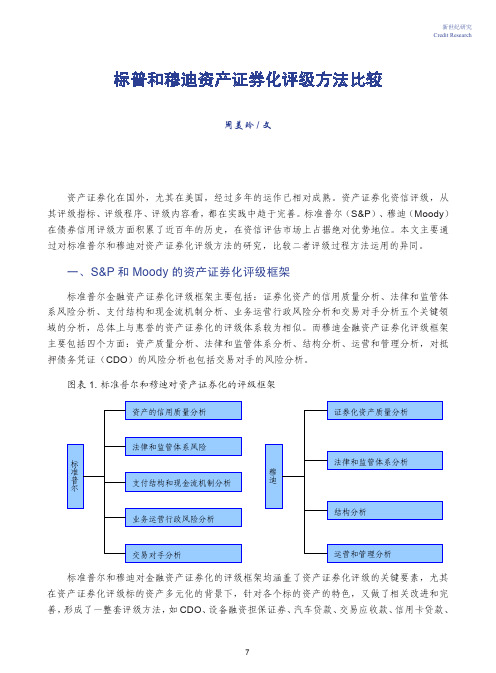
资产证券化在国外,尤其在美国,经过多年的运作已相对成熟。
资产证券化资信评级,从其评级指标、评级程序、评级内容看,都在实践中趋于完善。
标准普尔(S&P )、穆迪(Moody )在债券信用评级方面积累了近百年的历史,在资信评估市场上占据绝对优势地位。
本文主要通过对标准普尔和穆迪对资产证券化评级方法的研究,比较二者评级过程方法运用的异同。
一、S&P 和Moody 的资产证券化评级框架标准普尔金融资产证券化评级框架主要包括:证券化资产的信用质量分析、法律和监管体系风险分析、支付结构和现金流机制分析、业务运营行政风险分析和交易对手分析五个关键领域的分析,总体上与惠誉的资产证券化的评级体系较为相似。
而穆迪金融资产证券化评级框架主要包括四个方面:资产质量分析、法律和监管体系分析、结构分析、运营和管理分析,对抵押债务凭证(CDO )的风险分析也包括交易对手的风险分析。
图表1. 标准普尔和穆迪对资产证券化的评级框架标准普尔和穆迪对金融资产证券化的评级框架均涵盖了资产证券化评级的关键要素,尤其在资产证券化评级标的资产多元化的背景下,针对各个标的资产的特色,又做了相关改进和完善,形成了一整套评级方法,如CDO 、设备融资担保证券、汽车贷款、交易应收款、信用卡贷款、标普和穆迪资产证券化评级方法比较周美玲/文出口应收帐款担保证券、不动产担保证券等。
二、S&P和Moody的资产证券化评级方法比较(一)对证券化资产的信用质量分析标准普尔对证券化资产信用质量的分析侧重于确定在情景压力测试下的评级:●证券存续期间资产池中的基础资产出现违约或损失的比例;●如果有资产出现违约或损失,可以通过抵押、担保以及其他方式覆盖的比例;●最大债务人违约压力测试;●最大行业违约压力测试。
前两项决定了债务问题最终潜在的损失比例,而后两项决定了交易中的事件风险和模型风险。
在此基础上标准普尔采用各种分析方法和定量工具对来自内部和外部的信息进行评价,包括使用违约和现金流模型。
描写人的英语形容词

大学英语描写人的实用形容词( 171个) 1.able 有才干的,能干的2.active 主动的,活跃的3.adaptable 适应性强的4.adroit 灵巧的,机敏的5.aggressive 有进取心的6.alert 机灵的7.ambitious 有雄心壮志的8.amiable 和蔼可亲的9.amicable 友好的10.analytical 善于分析的11.apprehensive 有理解力的12.argumentative 好争辩的13.aspiring 有志气的,有抱负的14.attractive 有魅力的15.audacious 大胆的,有冒险精神的1.bad-tempered 脾气暴燥的2.big-mouth 多嘴多舌的3.bland 温和的,和蔼的,冷漠的4.bossy 专横跋扈的5.brave 勇敢的6.brilliant 有才气的1.capable 有能力的,有才能的2.careful 办事仔细的3.caring 有同情心的4.candid 正直的5.clever 机灵的,聪明的6.charitable 宽厚的,大慈大悲的7.cheerful 开朗的8.childish 幼稚的9.comical 滑稽的10.competent 能胜任的11.conceited 自以为是的12.confident 有信心的13.conscientious 认真的,自觉的14.considerate 体贴的15.constructive 建设性的16.contemplative 好沉思的17.cooperative 有合作精神的18.courageous 勇敢的,有胆量的19.creative 富创造力的20.cultured 有教养的1.dashing 有一股子冲劲的,有拼搏精神的2.dedicated 有奉献精神的3.demanding 苛刻的4.determined 坚决的5.devoted 有献身精神的6.dependable 可靠的7.diplomatic 老练的,有策略的8.depressing 沉闷的9.disciplined 守纪律的10.discreet (在行动,说话等方面)谨慎的11.dishonest 不诚实的12.disorganized 无组织的13.dutiful 尽职的14.dynamic 精悍的1.earnest 认真的2.easy-going 随和的3.efficient 有效率的4.energetic 精力充沛的5.enthusiastic 充满热情的6.expressive 善于表达1.faithful 守信的,忠诚的2.forceful (性格)坚强的3.forgetful 健忘的4.frank 直率的,真诚的5.friendly 友好的6.frugal 俭朴的7.funny 有趣的,古怪的1.generous 宽宏大量的2.genteel 有教养的,斯文的3.gentle 有礼貌的4.greedy贪婪的5.gullible 容易受骗上当的1.happy 开心的2.hard-working 勤劳的3.hearty 精神饱满的,衷心的4.helpful 助人的,有益的5.helpless 无助的,没用的6.honest 诚实的7.hospitable 殷勤的8.humble 恭顺的9.humorous 幽默的1. impartial 公正的2. inconsiderate 不顾及别人的,轻率的3. independent 有主见的4. industrious 勤奋的5. ingenious 有独创性的,足智多谋的6. initiative 首创精神7. intellective 有智力的8. intelligent 理解力强的9. inventive 有发明才能的,有创造力的1.just 正直的1.kind 仁慈的,和蔼的2.kind-hearted 好心的3.knowledgeable 有见识的zy 懒惰的,懒散的2.learned 精通某门学问的3.liberal 自由主义的,不受拘束的4.logical 条理分明的5.loyal 忠心耿耿的1.mean 吝啬的2.methodical 有方法的3.modest 谦虚的4.moody 情绪化的5.motivated 目的明确的1.narrow-minded 心胸狭窄的2.nasty 下流的,令人厌恶的3.nice 和蔼的,挑剔的,正派的,贞洁的4.noisy 聒噪的1.obedient 听话孝顺的2.objective 客观的3.open-minded 虚心的4.optimistic 乐观的5.orderly 守纪律的6.original 有独创性的,最初的6.outgoing 外向的,友好的1.painstaking 辛勤的,苦干的,刻苦的2.passionate 充满热情的3.persevering 不屈不挠的4.pessimistic 悲观的5.polite 有礼貌的6.popular 受欢迎的7.practical 实际的8.precise 一丝不苟的,说话清晰的9.punctual 严守时刻的10.purposeful 意志坚强的,有目的的11.pushy 有进取心的,有冲劲的1.qualified 合格的1.rational 有理性的2.realistic 实事求是的3.reasonable 讲道理的4.reliable 可信赖的5.responsible 负责的6.romantic 浪漫的,空想的1.self-conscious 自觉的2.selfish 自私的3.selfless 无私的4.sensible 明白事理的5.sensitive 敏感的6.sincere 真诚的7.skeptical 多疑的8.smart 精明的9.sociable 好交际的10.spirited 生气勃勃的11.sporting 光明正大的12.steady 塌实的13.straightforward 老实的,一直向前的14.strict 严格的15.stubborn 顽固的固执的16.supportive 助人的17.systematic 有系统的18.strong-willed 意志坚强的19.sympathetic确有同情心的20.sweet-tempered 性情温和的1.talented 有才能的2.temperate 稳健的3.thoughtful 体贴人的4.timid 但小的,羞怯的5.tireless 孜孜不倦的6.tolerant 容忍的7.trustful 容易相信人的8.trustworthy 值得信任的1.understanding 理解人的2.ungrateful 不领情的3.unselfish 无私的4.upright 正直的1.virtuous 善良的,贞洁的。
穆迪esg评分方法
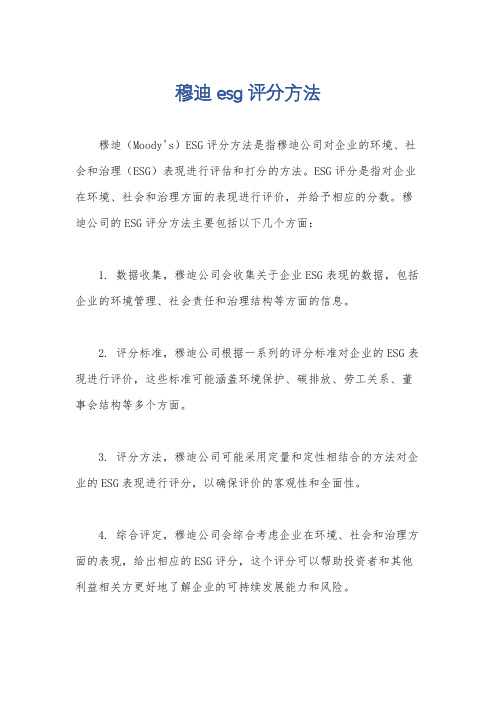
穆迪esg评分方法
穆迪(Moody's)ESG评分方法是指穆迪公司对企业的环境、社会和治理(ESG)表现进行评估和打分的方法。
ESG评分是指对企业在环境、社会和治理方面的表现进行评价,并给予相应的分数。
穆迪公司的ESG评分方法主要包括以下几个方面:
1. 数据收集,穆迪公司会收集关于企业ESG表现的数据,包括企业的环境管理、社会责任和治理结构等方面的信息。
2. 评分标准,穆迪公司根据一系列的评分标准对企业的ESG表现进行评价,这些标准可能涵盖环境保护、碳排放、劳工关系、董事会结构等多个方面。
3. 评分方法,穆迪公司可能采用定量和定性相结合的方法对企业的ESG表现进行评分,以确保评价的客观性和全面性。
4. 综合评定,穆迪公司会综合考虑企业在环境、社会和治理方面的表现,给出相应的ESG评分,这个评分可以帮助投资者和其他利益相关方更好地了解企业的可持续发展能力和风险。
总的来说,穆迪公司的ESG评分方法是通过收集数据、制定评
分标准、采用多种评分方法并进行综合评定,来评价企业在环境、
社会和治理方面的表现,为投资者和利益相关方提供全面的ESG信息。
这种评分方法有助于推动企业改善ESG表现,促进可持续发展。
Moody-International-Group-Presentation

2007 Investcorp acquires Moody International and Randy Smith Training Solutions is acquired by Moody International
2008 Second year in a row Moody is one of top 100 private equitybacked midmarket companies
• Supplier Inspection and Expediting • Construction/ Project Supervision • Managed Services Solutions • In-Service Inspection • Technical Auditing/ Supplier Assessments
Technical St ffi T h i l Staffing Services S i
• Contract Staffing • Permanent Placement Services
Consulting & Training
• Behavior-based Safety Training • Leadership Training • Well Control Training • Management System Auditor Training • Welding and Materials Training
Construction Supervision Project Supervision Pipeline Construction / Installation Fabrication Yards and Offshore
国际三大评级机构
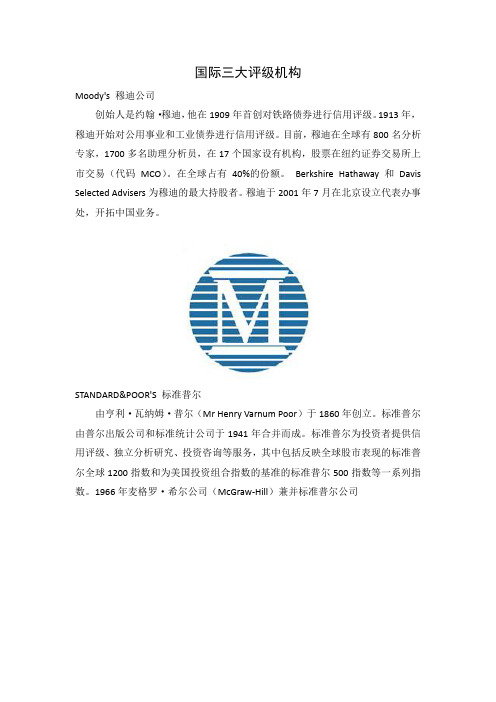
国际三大评级机构Moody's 穆迪公司创始人是约翰·穆迪,他在1909年首创对铁路债券进行信用评级。
1913年,穆迪开始对公用事业和工业债券进行信用评级。
目前,穆迪在全球有800名分析专家,1700多名助理分析员,在17个国家设有机构,股票在纽约证券交易所上市交易(代码MCO)。
在全球占有40%的份额。
Berkshire Hathaway和Davis Selected Advisers为穆迪的最大持股者。
穆迪于2001年7月在北京设立代表办事处,开拓中国业务。
STANDARD&POOR'S 标准普尔由亨利·瓦纳姆·普尔(Mr Henry Varnum Poor)于1860年创立。
标准普尔由普尔出版公司和标准统计公司于1941年合并而成。
标准普尔为投资者提供信用评级、独立分析研究、投资咨询等服务,其中包括反映全球股市表现的标准普尔全球1200指数和为美国投资组合指数的基准的标准普尔500指数等一系列指数。
1966年麦格罗·希尔公司(McGraw-Hill)兼并标准普尔公司FitchRatings 惠誉国际1913年由约翰·惠誉(John K.Fitch)创办。
1997年惠誉国际并购了另一家评级机构IBCA,2000年并购了DUFF & PHELPS,随后又买下了Thomson Bankwatch,目前,公司97%的股权由法国FIMALAC公司控制。
-------------------------------------------*1975年美国证券交易委员会SEC认可惠誉国际、标准普尔、穆迪为“全国认定的评级组织”或称“NRSRO”(Nationally Recognized Statistical Rating Organization)。
惠誉评级是与标普、穆迪齐名的全球三大评级公司之一。
在三大评级公司里,惠誉是最早进入中国的。
autumn形容词
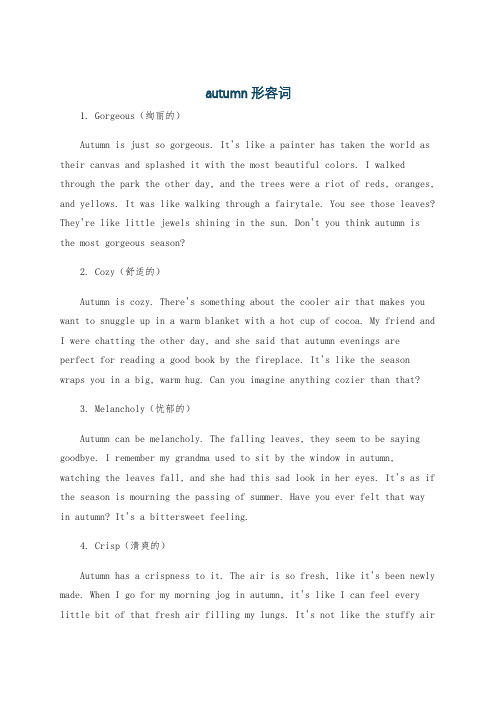
autumn形容词1. Gorgeous(绚丽的)Autumn is just so gorgeous. It's like a painter has taken the world as their canvas and splashed it with the most beautiful colors. I walked through the park the other day, and the trees were a riot of reds, oranges, and yellows. It was like walking through a fairytale. You see those leaves? They're like little jewels shining in the sun. Don't you think autumn is the most gorgeous season?2. Cozy(舒适的)Autumn is cozy. There's something about the cooler air that makes you want to snuggle up in a warm blanket with a hot cup of cocoa. My friend and I were chatting the other day, and she said that autumn evenings areperfect for reading a good book by the fireplace. It's like the season wraps you in a big, warm hug. Can you imagine anything cozier than that?3. Melancholy(忧郁的)Autumn can be melancholy. The falling leaves, they seem to be saying goodbye. I remember my grandma used to sit by the window in autumn, watching the leaves fall, and she had this sad look in her eyes. It's as if the season is mourning the passing of summer. Have you ever felt that way in autumn? It's a bittersweet feeling.4. Crisp(清爽的)Autumn has a crispness to it. The air is so fresh, like it's been newly made. When I go for my morning jog in autumn, it's like I can feel every little bit of that fresh air filling my lungs. It's not like the stuffy airof summer. It's like nature's way of giving us a little pick - me - up. Don't you love that crisp feeling?5. Enchanting(迷人的)Autumn is enchanting. It has this magic that draws you in. My sister and I went on a hike in the woods last autumn. The way the sunlightfiltered through the golden leaves was like a spell. We were just walking and talking, and it felt like we were in a different world. Isn't autumn an enchanting time?6. Tranquil(宁静的)Autumn is tranquil. There's a stillness in the air. I was sitting in my backyard one autumn afternoon, and all I could hear was the occasional rustle of a leaf falling. It was so peaceful. It's like the world has taken a deep breath and is just relaxing. Have you ever noticed how tranquil autumn can be?7. Bountiful(丰富的)Autumn is bountiful. Look at all the harvest! The farmers' markets are filled with fresh produce. My neighbor was showing off his huge pumpkins the other day. It's like the earth is giving us one last big gift before winter. Don't you think autumn is a bountiful season?8. Moody(喜怒无常的)Autumn can be moody. One day it's sunny and beautiful, and the nextit's cloudy and a bit dreary. I was planning a picnic with my friends in autumn, and we had to change our plans because of the sudden change in weather. It's like autumn has its own personality and can't make up its mind. Have you experienced autumn's moodiness?9. Inviting(诱人的)Autumn is inviting. The smell of freshly baked pies and cinnamon rolls fills the air. My mom was baking the other day, and the whole house smelled amazing. It's like autumn is calling you to come in and enjoy somedelicious treats. Can't you just feel that invitation?10. Rustic(质朴的)Autumn has a rustic charm. The old barns and fences look even more beautiful with the autumn backdrop. I visited a small countryside villagein autumn once, and it was like stepping back in time. The simplicity of it all was so appealing. Don't you find autumn rustic?11. Whimsical(异想天开的)Autumn can be whimsical. The way the leaves swirl in the wind is like a little dance. I was watching the leaves outside my window with my little brother, and he said it looked like the leaves were having a party. It's like autumn brings out this playful side of nature. Have you ever seen autumn's whimsy?12. Dreamy(梦幻的)Autumn is dreamy. The soft light in the afternoons makes everything seem a bit hazy. I was walking in the park with my partner, and we bothfelt like we were in a dream. It's like autumn has this ability to make the ordinary seem extraordinary. Don't you think autumn is dreamy?13. Nostalgic(怀旧的)Autumn is nostalgic. It makes me think of all the good times I had in the past. I was looking at old family photos from autumns long ago, and itbrought back so many memories. It's like autumn is a time capsule. Have you ever felt nostalgic in autumn?14. Spicy(辛辣的,此处形容充满活力)Autumn is spicy. There's a kind of energy in the air. The festivals, the football games, everyone seems more alive. My dad and I went to a football game in autumn, and the crowd was so enthusiastic. It's like autumn has this spicy kick to it. Don't you feel that spiciness?15. Mellow(柔和的)Autumn is mellow. The colors are not too bright, not too dull. It'slike a soft melody. I was painting a picture of an autumn scene once, and I found myself using these really mellow colors. It's like autumn has a calming effect on everything. Have you noticed how mellow autumn is?16. Poetic(富有诗意的)Autumn is poetic. Every fallen leaf, every gust of wind seems to have a story to tell. I was reading some poetry about autumn with my English teacher, and it was like the words were written just for that season. It's like autumn is a muse for poets. Don't you think autumn is poetic?17. Vivid(生动的)Autumn is vivid. The contrast of the colors against the blue sky is amazing. I took a photo of an autumn tree the other day, and when I looked at it later, it was like the tree was jumping out of the picture. It's like autumn is a master of creating vivid scenes. Have you seen how vivid autumn can be?18. Solemn(庄严的)Autumn can be solemn. The long shadows and the quietude can give a sense of seriousness. I went to a cemetery in autumn once, and the whole atmosphere was very solemn. It's like autumn is a time to reflect. Have you ever felt that solemnity in autumn?19. Tempting(诱人的)Autumn is tempting. All those warm sweaters and scarves in the stores are calling my name. I was shopping with my girlfriends in autumn, and we couldn't resist trying on all the cute autumn clothes. It's like autumn is tempting us to look our best. Don't you find autumn tempting?20. Heartwarming(暖心的)Autumn is heartwarming. The family gatherings around the Thanksgiving table, the sharing of stories. I had a big family dinner last autumn, and it was just full of love and laughter. It's like autumn brings out the best in people. Don't you think autumn is heartwarming?。
moody美瞳营销劣势
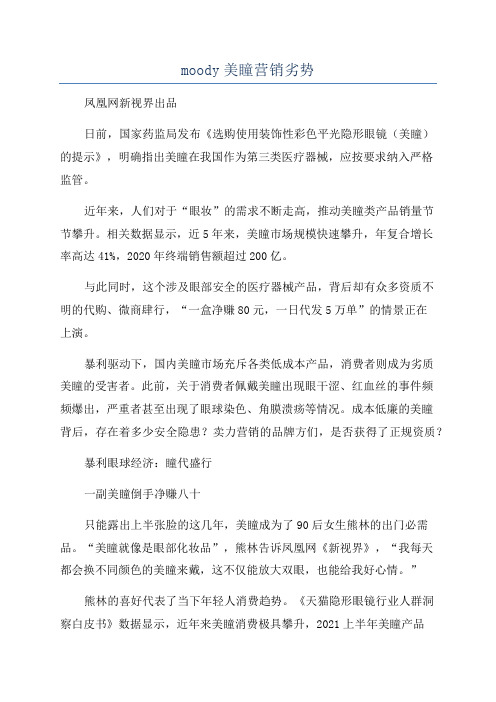
moody美瞳营销劣势凤凰网新视界出品日前,国家药监局发布《选购使用装饰性彩色平光隐形眼镜(美瞳)的提示》,明确指出美瞳在我国作为第三类医疗器械,应按要求纳入严格监管。
近年来,人们对于“眼妆”的需求不断走高,推动美瞳类产品销量节节攀升。
相关数据显示,近5年来,美瞳市场规模快速攀升,年复合增长率高达41%,2020年终端销售额超过200亿。
与此同时,这个涉及眼部安全的医疗器械产品,背后却有众多资质不明的代购、微商肆行,“一盒净赚80元,一日代发5万单”的情景正在上演。
暴利驱动下,国内美瞳市场充斥各类低成本产品,消费者则成为劣质美瞳的受害者。
此前,关于消费者佩戴美瞳出现眼干涩、红血丝的事件频频爆出,严重者甚至出现了眼球染色、角膜溃疡等情况。
成本低廉的美瞳背后,存在着多少安全隐患?卖力营销的品牌方们,是否获得了正规资质?暴利眼球经济:瞳代盛行一副美瞳倒手净赚八十只能露出上半张脸的这几年,美瞳成为了90后女生熊林的出门必需品。
“美瞳就像是眼部化妆品”,熊林告诉凤凰网《新视界》,“我每天都会换不同颜色的美瞳来戴,这不仅能放大双眼,也能给我好心情。
”熊林的喜好代表了当下年轻人消费趋势。
《天猫隐形眼镜行业人群洞察白皮书》数据显示,近年来美瞳消费极具攀升,2021上半年美瞳产品GMV年增速高达83%,远远高于2021年全年化妆品类的14%增长率,消费主要以90后和95后为主导。
2021年11月,Moody完成总值超10亿人民币C轮融资;3月,4iNLOOK完成1亿B+轮融资,总融资金额超过4亿元;今年5月24日,国风系美瞳品牌NORVEY也完成了来自东华的3500万元人民币天使轮融资。
然而,快速增长的美瞳市场却是鱼龙混杂、乱象丛生,商家从业资质不明、一证多用已成“行规”,瞳代肆行。
有7年从业经验的“瞳代”张婷表示,自己从15年开始兼职代理,陆陆续续加过一些代理群。
这些代理商经常会以日赚斗金、无需资质的话术来吸引宝妈、学生加入,通常上家大额进货,再以低价批发给下游代理商。
Moodys-KMV模型
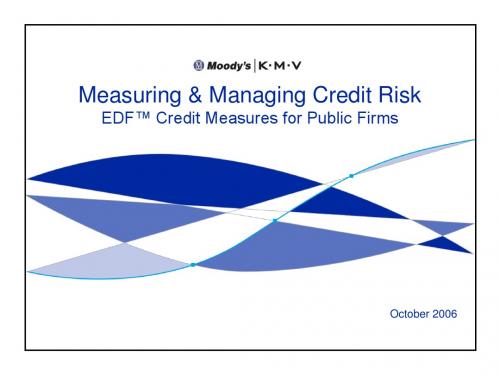
Agency Ratings: Another Example
1
2
3
4
5
6
7
8
6
Measuring & Managing Credit Risk - EDF™ Credit Measures
Copyright © 2006 Moody’s KMV Company. All Rights Reserved.
1-Year EDF N-TROPICAL SPORTSWEAR INTL CP-EDF S&P Rating N-TROPICAL SPORTSWEAR INTL CP-S&P
Defaulted December 2004
S&P Rating
20 Ca C 15 Caa CC CCC 10 7 B 5 B 2 1 Ba BB
1-Year EDF
.50 Baa BBB A .20 A .15 .10 AA Aa .05
Source: Credit Monitor
.02 Aaa AAA 06/00 11/00 05/01 11/01 05/02 11/02 05/03 11/03 05/04 11/04
1
05/05
2 3 4 5 6 7 8
1
2
3
4
5
6
7
8
3
Measuring & Managing Credit Risk - EDF™ Credit Measures
Copyright © 2006 Moody’s KMV Company. All Rights Reserved.
Default Example: Collins & Aikman Corp
kac—moody代数的一类子代数

kac—moody代数的一类子代数Kac–Moody algebra is an important class of Lie algebras, providing a powerful tool for studying symmetry in mathematics and physics. This article seeks to explain the fundamentals of Kac–Moody algebras, as well as explore their applications.Kac–Moody代数是一种理论数学语言,它可以用来描述具有指数增长、根与偶无关性、生成元之间的特定关系以及在无限维空间中提供自由量的数学模型。
它是为了解决无限维空间中物理概念的问题而被一次性地求出来的。
通常,Kac–Moody代数有三个主要的性质:它们具有无穷多维空间;它们具有指数增长的衰减函数;以及它们提供一类子代数—Weyl–Kac–Moody代数。
一、什么是Weyl–Kac–Moody代数?Weyl–Kac–Moody代数是Kac–Moody代数的一种特殊方式,它可以用来研究和描述无限维空间中物理概念,具有指数增长的减弱函数以及根与偶无关性特性。
它们由E.H.Weyl提出并创建,它构成了一个具有无穷多维空间的抽象架构,形成了一类特殊的代数,其中每个代数以及每个生成元之间的特定关系都可以用来描述物体在不同维度空间中的行为。
二、Weyl–Kac–Moody代数的应用Weyl–Kac–Moody代数的主要作用是解决物体在不同维度空间中的行为,通过将各个维度的代数和生成元之间的特定关系组合在一起,来描述各个维度空间中物体的关系和共性行为。
它可以应用于许多领域,包括微观宇宙物理学和抽象几何学。
此外,Kac–Moody代数本身也被广泛应用于几何拓扑学、力学以及因果论中。
三、Weyl–Kac–Moody代数的优缺点Weyl–Kac–Moody代数具有以下优点:(1)可用较少的参数来模拟复杂的空间结构;(2)可以解释受少量外部因素影响时结构会发生什么样的变化;(3)可以用于描述不同维度空间中物体之间的关系。
世界三大评级机构及评级对照介绍
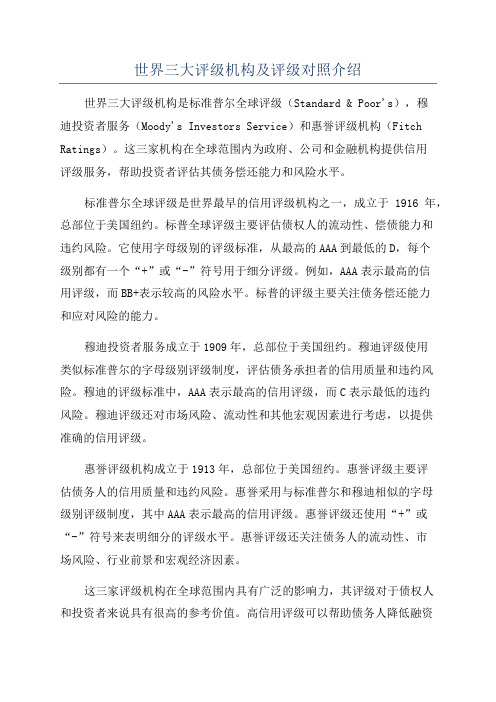
世界三大评级机构及评级对照介绍世界三大评级机构是标准普尔全球评级(Standard & Poor's),穆迪投资者服务(Moody's Investors Service)和惠誉评级机构(Fitch Ratings)。
这三家机构在全球范围内为政府、公司和金融机构提供信用评级服务,帮助投资者评估其债务偿还能力和风险水平。
标准普尔全球评级是世界最早的信用评级机构之一,成立于1916年,总部位于美国纽约。
标普全球评级主要评估债权人的流动性、偿债能力和违约风险。
它使用字母级别的评级标准,从最高的AAA到最低的D,每个级别都有一个“+”或“-”符号用于细分评级。
例如,AAA表示最高的信用评级,而BB+表示较高的风险水平。
标普的评级主要关注债务偿还能力和应对风险的能力。
穆迪投资者服务成立于1909年,总部位于美国纽约。
穆迪评级使用类似标准普尔的字母级别评级制度,评估债务承担者的信用质量和违约风险。
穆迪的评级标准中,AAA表示最高的信用评级,而C表示最低的违约风险。
穆迪评级还对市场风险、流动性和其他宏观因素进行考虑,以提供准确的信用评级。
惠誉评级机构成立于1913年,总部位于美国纽约。
惠誉评级主要评估债务人的信用质量和违约风险。
惠誉采用与标准普尔和穆迪相似的字母级别评级制度,其中AAA表示最高的信用评级。
惠誉评级还使用“+”或“-”符号来表明细分的评级水平。
惠誉评级还关注债务人的流动性、市场风险、行业前景和宏观经济因素。
这三家评级机构在全球范围内具有广泛的影响力,其评级对于债权人和投资者来说具有很高的参考价值。
高信用评级可以帮助债务人降低融资成本,吸引更多的投资者。
相反,低信用评级可能会增加融资成本,并限制债务人的融资能力。
评级机构的评级对照主要是在评级标准和评级分级上。
虽然这三家评级机构使用类似的字母评级制度,但它们的评级结果可能会略有不同。
这可能是因为评级机构在评估债务人时可能会侧重不同的因素,以及使用不同的方法和数据。
【Intertek并购Moody——强强联手,锐化竞争优势】 竞争优势
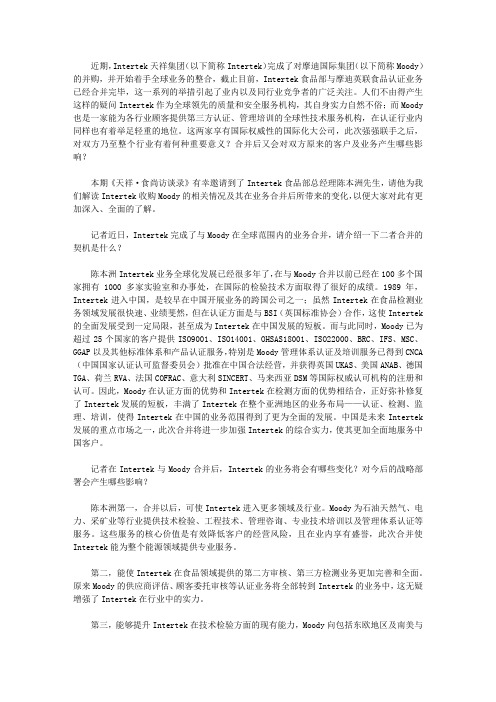
近期,Intertek天祥集团(以下简称Intertek)完成了对摩迪国际集团(以下简称Moody)的并购,并开始着手全球业务的整合,截止目前,Intertek食品部与摩迪英联食品认证业务已经合并完毕,这一系列的举措引起了业内以及同行业竞争者的广泛关注。
人们不由得产生这样的疑问Intertek作为全球领先的质量和安全服务机构,其自身实力自然不俗;而Moody 也是一家能为各行业顾客提供第三方认证、管理培训的全球性技术服务机构,在认证行业内同样也有着举足轻重的地位。
这两家享有国际权威性的国际化大公司,此次强强联手之后,对双方乃至整个行业有着何种重要意义?合并后又会对双方原来的客户及业务产生哪些影响?本期《天祥·食尚访谈录》有幸邀请到了Intertek食品部总经理陈本洲先生,请他为我们解读Intertek收购Moody的相关情况及其在业务合并后所带来的变化,以便大家对此有更加深入、全面的了解。
记者近日,Intertek完成了与Moody在全球范围内的业务合并,请介绍一下二者合并的契机是什么?陈本洲Intertek业务全球化发展已经很多年了,在与Moody合并以前已经在100多个国家拥有1000多家实验室和办事处,在国际的检验技术方面取得了很好的成绩。
1989年,Intertek进入中国,是较早在中国开展业务的跨国公司之一;虽然Intertek在食品检测业务领域发展很快速、业绩斐然,但在认证方面是与BSI(英国标准协会)合作,这使Intertek 的全面发展受到一定局限,甚至成为Intertek在中国发展的短板。
而与此同时,Moody已为超过25个国家的客户提供ISO9001、ISO14001、OHSAS18001、ISO22000、BRC、IFS、MSC、GGAP以及其他标准体系和产品认证服务,特别是Moody管理体系认证及培训服务已得到CNCA (中国国家认证认可监督委员会)批准在中国合法经营,并获得英国UKAS、美国ANAB、德国TGA、荷兰RVA、法国COFRAC、意大利SINCERT、马来西亚DSM等国际权威认可机构的注册和认可。
MOODY资料

按期交付、符合规范
随着经济全球化的日益发展,大型工业建设项目管理 日渐复杂,工程管理团队面临的最大挑战是对全球采 购的产品实施统一质量标准和按期交货。通过分布在 世界各地的技术人员和当地机构,摩迪国际集团代表 客户对各地采购产品的制造过程进行有效监督和管 理,保证产品满足采购合同有关质量和进度的要求。
管理体系类
质量 ................................................................................................................................. 10 环境 ................................................................................................................................. 14 职业健康和安全 ............................................................................................................... 17 信息安全 .......................................................................................................................... 20 社会责任 .......................................................................................................................... 21 有害物质 .......................................................................................................................... 23 食品安全 .......................................................................................................................... 24 汽车质量管理 ................................................................................................................... 33 石油质量管理 ................................................................................................................... 34 综合管理体系 ................................................................................................................... 9 管理工具 .......................................................................................................................... 35
moody's评级符号定义
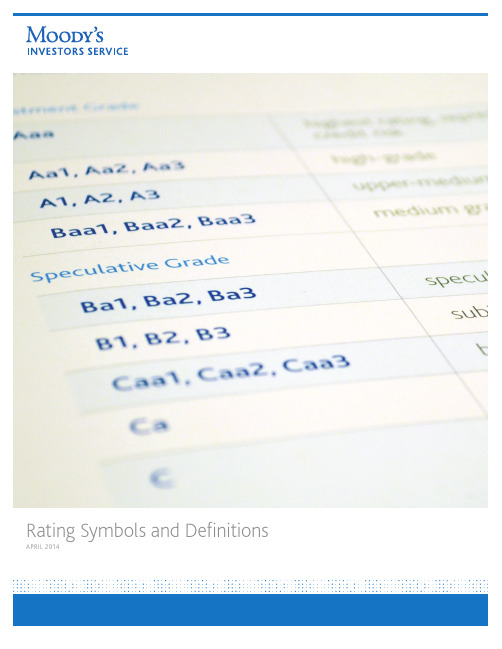
Rating Symbols and Definitions APRIL 2014MARch 2008table of ContentsPreface (2)Moody’s Standing Committee onRating Symbols and Definitions (3)Credit Rating Services (4)Moody’s Global Rating Scales (4)Linkage Between the Global Long-Termand Short-Term Rating Scales (6)Obligations and Issuers Rated on theGlobal Long-Term and Short-Term Rating Scales (7)US Municipal Short-Term Debt andDemand Obligation Ratings (10)National Scale Long-Term Ratings (12)National Scale Short-Term Ratings (13)Probability of Default Ratings (15)Other Permissible Services (16)Assessments of Infonavit’s Third PartyCollection Agencies (16)Bond Fund Ratings (17)Common Representative Quality Assessments (18)Contract Enforceability Indicatorsfor Mexican States (19)Credit Estimates (20)Equity Fund Assessments (21)Indicative Assessment Services (21)Indicative Ratings (22)Investment Manager Quality Assessments (22)Market Risk Ratings (23)Money Market Fund (mf) Ratings (24)National Scale Stock Ratings (25)Originator Assessments (25)Q-Scores (25)Rating Assessment Services (25)Servicer Quality Assessments (26)Trustee Quality Assessments (27)Other Rating Symbols (28)Expected ratings - e (28)Provisional Ratings - (P) (28)Refundeds - # (28)Withdrawn - WR (28)Not Rated - NR (28)Not Available - NAV (28)Terminated Without Rating - TWR (28)Inputs to Rating Services (29)Baseline Credit Assessments (29)Bank Financial Strength Ratings (30)Loss Given Default Assessments (32)Structured Credit Assessments (SCAs) (33)Other Definitions (34)Rating Outlooks (34)Rating Reviews (34)Confirmation of a Rating (35)Affirmation of a Rating (35)Anticipated/Subsequent Ratings Process (35)Rating Agency Conditions (RACs) (35)Covenant Quality Assessments (36)Speculative Grade Liquidity Ratings (36)Definition of Default (36)Definition of Impairment (37)Definition of Loss-Given-Default (38)Long-Term Credit Ratings for Defaultedor Impaired Securities (38)Credit Rating Methodologies (39)Key Rating Assumptions (40)Special Comments (42)Country Ceilings for Bonds and OtherForeign Currency Obligations (42)Country Ceilings for Foreign CurrencyBank Deposits (42)Country Ceiling for Bonds and OtherLocal Currency Obligations (43)Local Currency Deposit Ceiling (43)Hybrid Security Baskets (43)Timely Payment Indicator (TPI) (43)Rating SymbolS and definitionS Moody’s Investors servIce 1PrefaceIn the spirit of promoting transparency and clarity, Moody’s Standing Committee on Rating Symbolsand Definitions offers this updated reference guide which defines Moody’s various ratings symbols, ratingscales and other ratings-related definitions.Since John Moody devised the first bond ratings almost a century ago, Moody’s rating systems haveevolved in response to the increasing depth and breadth of the global capital markets. Much of theinnovation in Moody’s rating system is a response to market needs for clarity around the componentsofcredit risk or to demands for finer distinctions in rating classifications.The Standing Committee on Rating Symbols and Definitions, one of several at Moody’s that focuses oncredit policy issues, is comprised of structured finance, corporate finance, public finance, and financialinstitutions credit analysts, as well as representatives from the Credit Policy group. The names, directtelephone numbers and e-mail addresses of the members of the Standing Committee are listed below.I invite you to contact us with your comments.Ken EmeryChair, Standing Committee on Rating Symbols and Definitions2 Moody’s Investors servIce Rating SymbolS and definitionSRating SymbolS and definitionS Moody’s Investors servIce 3Ken Emery - Chair+1.212.553.4415Senior Vice President, Credit Policy Group kenneth.emery@Richard Cantor+1.212.553.3628Chief Credit Officer, Moody’s Investors Service richard.cantor@Henry Charpentier+34.91.768.8216Managing Director, Structured Finance Group henry.charpentier@Jack Dorer+1.212.553.1332Managing Director, US Public Finance Group jack.dorer@David Fanger+1.212.553.4342Senior Vice President, Financial Institutions Group david.fanger@Joseph Grohotolski+1.212.553.4619Vice President, Senior Compliance Officer joseph.grohotolski@Matthew Jones+1.415.274.1735Senior Vice President, U.S. Public Finance Group matthew.jones@John Kriens+1.212.553.1175Vice President, Information Technology John.Kriens@Marie Menendez+1.212.553.4126Senior Vice President, Corporate Finance Group marie.menendez@Bart Oosterveld+1.212.553.7914Managing Director, Sovereign Risk Group bart.oosterveld@David Rosa+4420.7772.5341Senior Vice President, Credit Policy Group david.rosa@Russell Solomon+1.212.553.4301Senior Vice President, Corporate Finance Group russell.solomon@Celina Vansetti-Hutchins+1.212.553.4845Managing Director, Financial Institutions Group celina.vansetti-hutchins@Alastair Wilson+44.207.772.1372Chief Credit Officer, Europe alastair.wilson@ moody’s Standing Committee on Rating Symbols and definitionsCredit Rating ServicesMoody’s Global Rating ScalesRatings assigned on Moody’s global long-term and short-term rating scales are forward-lookingopinions of the relative credit risks of financial obligations issued by non-financial corporates, financialinstitutions, structured finance vehicles, project finance vehicles, and public sector entities. Long-termratings are assigned to issuers or obligations with an original maturity of one year or more and reflectboth on the likelihood of a default on contractually promised payments and the expected financial losssuffered in the event of default.1 Short-term ratings are assigned to obligations with an original maturityof thirteen months or less and reflect the likelihood of a default on contractually promised payments.2Moody’s differentiates structured finance ratings from fundamental ratings (i.e., ratings on nonfinancialcorporate, financial institution, and public sector entities) on the global long-term scale by adding (sf) toall structured finance ratings. The (sf) indicator was introduced on August 11, 2010 and explained in aspecial comment entitled, “Moody’s Structured Finance Rating Scale.” The addition of (sf) to structuredfinance ratings should eliminate any presumption that such ratings and fundamental ratings at the sameletter grade level will behave the same. The (sf) indicator for structured finance security ratings indicatesthat otherwise similarly rated structured finance and fundamental securities may have different riskcharacteristics. Through its current methodologies, however, Moody’s aspire to achieve broad expectedequivalence in structured finance and fundamental rating performance when measured over a long periodof time.1 F or certain structured finance, preferred stock and hybrid securities in which payment default events are either notdefined or do not match investors’ expectations for timely payment, the ratings reflect the likelihood of impairment(as defined below in this publication) and the expected financial loss in the event of impairment.2 F or certain structured finance, preferred stock and hybrid securities in which payment default events are either notdefined or do not match investors’ expectations for timely payment, the ratings reflect the likelihood of impairment(as defined below in this publication).4 Moody’s Investors servIce Rating SymbolS and definitionSRating SymbolS and definitionS Moody’s Investors servIce56 Moody’s Investors servIceRating SymbolS and definitionSLinkage Between the Global Long-Term and Short-Term Rating ScalesThe following table indicates the long-term ratings consistent with different short-term ratings when such long-term ratings exist.3LONG-TERMRATINGSHORT-TERM RATING3 S tructured finance short-term ratings are usually based either on the short-term rating of a support provider or on an assessment of cash flows available to retire the financial obligation.Obligations and Issuers Rated on the Global Long-Term and Short-Term Rating Scales LONG-TERM AND SHORT-TERM OBLIGATION RATINGSMoody’s assigns ratings to long-term and short-term financial obligations. Long-term ratings are assigned to issuers or obligations with an original maturity of one year or more and reflect both on the likelihood of a default on contractually promised payments and the expected financial loss suffered in the event of default. Short-term ratings are assigned to obligations with an original maturity of thirteen months or less and reflect the likelihood of a default on contractually promised payments.BANK DEPOSIT RATINGSBank Deposit Ratings are opinions of a bank’s ability to repay punctually its foreign and/or domestic currency deposit obligations and, in the case of long-term deposit ratings, also reflect the expected financial loss of the default. Bank Deposit Ratings do not apply to deposits that are subject to a public or private insurance scheme; rather, the ratings apply to uninsured deposits, but they may in some cases incorporate the possibility that official support might in certain cases extend to uninsured as well as insured deposits. Foreign currency deposit ratings are subject to Moody’s country ceilings for foreign currency deposits. This may result in the assignment of a different (and typically lower) rating for the foreign currency deposits relative to the bank’s rating for domestic currency deposits.CORPORATE FAMILY RATINGSMoody’s Corporate Family Ratings (CFRs) are long-term ratings that reflect the likelihood of a default on a corporate family’s contractually promised payments and the expected financial loss suffered in the event of default. A CFR is assigned to a corporate family as if it had and a single class of debt and a single consolidated legal entity structure. CFRs are generally employed for speculative grade obligors, but may also be assigned to investment grade obligors. The CFR normally applies to all affiliates under the management control of the entity to which it is assigned. For financial institutions or other complex entities, CFRs may also be assigned to an association or group where the group may not exercise full management control, but where strong intra-group support and cohesion among individual group members may warrant a rating for the group or association. A CFR does not reference an obligation or class of debt and thus does not reflect priority of claim.COUNTERPARTY RATINGSCounterparty Ratings are assigned to structured financial operating companies and are founded upon an assessment of their ability and willingness to honor their obligations under financial contracts. COUNTERPARTY INSTRUMENT RATINGSCounterparty Instrument Ratings are assigned to a financial contract and measure the risk posed to a counterparty arising from a special purpose vehicle’s (SPV’s) default with respect to its obligations under the referenced financial contract.CREDIT DEFAULT SWAPS RATINGSCredit Default Swaps Ratings measure the risk associated with the obligations that a credit protection provider has with respect to credit events under the terms of the transaction. The ratings do not address potential losses resulting from an early termination of the transaction, nor any market risk associated with the transaction.Rating SymbolS and definitionS Moody’s Investors servIce 7ENHANCED RATINGSEnhanced Ratings only pertain to US municipal securities. An enhanced rating is Moody’s publishedassessment of a particular obligation’s credit quality absent any insurance or wrap from a financialguarantor, but reflecting the underlying issue’s standalone credit quality as well as any credit supportprovided by a state credit enhancement program.INSURANCE FINANCIAL STRENGTH RATINGSInsurance Financial Strength Ratings are opinions of the ability of insurance companies to pay punctuallysenior policyholder claims and obligations and also reflect the expected financial loss suffered in theevent of default . Specific obligations are considered unrated unless they are individually rated becausethe standing of a particular insurance obligation would depend on an assessment of its relative standingunder those laws governing both the obligation and the insurance company.INSURED RATINGSAn insured or wrapped rating is Moody’s assessment of a particular obligation’s credit quality given thecredit enhancement provided by a financial guarantor. Moody’s insured ratings apply a credit substitutionmethodology, whereby the debt rating matches the higher of (i) the guarantor’s financial strength ratingand (ii) any published underlying or enhanced rating on the security.ISSUER RATINGSIssuer Ratings are opinions of the ability of entities to honor senior unsecured financial counterpartyobligations and contracts. As such, Issuer Ratings incorporate any external support that is expected toapply to all current and future issuance of senior unsecured financial obligations and contracts, such asexplicit support stemming from a guarantee of all senior unsecured financial obligations and contracts,and/or implicit support for issuers subject to joint default analysis (e.g. banks and government-relatedissuers). Issuer Ratings do not incorporate support arrangements, such as guarantees, that apply only tospecific (but not to all) senior unsecured financial obligations and contracts.MEDIUM-TERM NOTE PROGRAM RATINGSMoody’s assigns provisional ratings to medium-term note (MTN) programs and definitive ratings to theindividual debt securities issued from them (referred to as drawdowns or notes).MTN program ratings are intended to reflect the ratings likely to be assigned to drawdowns issued fromthe program with the specified priority of claim (e.g. senior or subordinated). To capture the contingentnature of a program rating, Moody’s assigns provisional ratings to MTN programs. A provisional rating isdenoted by a (P) in front of the rating and is defined elsewhere in this document.The rating assigned to a drawdown from a rated MTN or bank/deposit note program is definitive innature, and may differ from the program rating if the drawdown is exposed to additional credit risksbesides the issuer’s default, such as links to the defaults of other issuers, or has other structural featuresthat warrant a different rating. In some circumstances, no rating may be assigned to a drawdown.Moody’s encourages market participants to contact Moody’s Ratings Desks or visit directly if they have questions regarding ratings for specific notes issued under a medium-term noteprogram. Unrated notes issued under an MTN program may be assigned an NR (not rated) symbol.8 Moody’s Investors servIce Rating SymbolS and definitionSSTRUCTURED FINANCE INTEREST ONLY SECURITY (IO) RATINGSA structured finance IO is a stream of cash flows that is a fraction of the interest flows from one or multiple referenced securities or assets in a structured finance transaction. IO ratings address the likelihood and degree to which payments made to the IO noteholders will be impacted by credit losses to the security, securities or assets referenced by the IO. Such IO securities do not have a principal balance. Other non-credit risks, such as a prepayment of the referenced securities or assets, are not addressed by the rating, although they may impact payments made to the noteholders.UNDERLYING RATINGSAn underlying rating is Moody’s assessment of a particular obligation’s credit quality absent any insurance or wrap from a financial guarantor or other credit enhancement.For US municipal securities, the underlying rating will reflect the underlying issue’s standalone credit quality absent any credit support provided by a state credit enhancement program.US BANK OTHER SENIOR OBLIGATION RATINGSRatings on US Banks’ Other Senior Obligations (OSOs) are opinions of a US bank’s ability to repay punctually its foreign deposits and International Banking Facility deposits, as well as other seniornon-depository obligations, including bank notes, letter-of-credit supported obligations, federal funds and financial contracts. US law provides that foreign deposits and senior unsecured obligations, including bank notes, will rank behind domestic deposit obligations of US banks in the event of liquidation. A rating distinction between domestic deposits and OSOs will be reflected in those cases where there is a material susceptibility for impairment at a future time.US Municipal Short-Term Debt and Demand Obligation RatingsSHORT-TERM OBLIGATION RATINGSWhile the global short-term ‘prime’ rating scale is applied to US municipal tax-exempt commercial paper, these programs are typically backed by external letters of credit or liquidity facilities and their short-term prime ratings usually map to the long-term rating of the enhancing bank or financial institution and not to the municipality’s rating. Other short-term municipal obligations, which generally have different funding sources for repayment, are rated using two additional short-term rating scales (i.e., the MIG and VMIG scales discussed below).The Municipal Investment Grade (MIG) scale is used to rate US municipal bond anticipation notes of up to three years maturity. Municipal notes rated on the MIG scale may be secured by either pledged revenues or proceeds of a take-out financing received prior to note maturity. MIG ratings expire at the maturity of the obligation, and the issuer’s long-term rating is only one consideration in assigning the MIG rating. MIG ratings are divided into three levels—MIG 1 through MIG 3—while speculative grade short-term obligations are designated SG.DEMAND OBLIGATION RATINGSIn the case of variable rate demand obligations (VRDOs), a two-component rating is assigned: a long or short-term debt rating and a demand obligation rating. The first element represents Moody’s evaluation of risk associated with scheduled principal and interest payments. The second element represents Moody’s evaluation of risk associated with the ability to receive purchase price upon demand (“demand feature”). The second element uses a rating from a variation of the MIG scale called the Variable Municipal Investment Grade (VMIG) scale. The rating transitions on the VMIG scale, as shown in the diagram below, differ from those on the Prime scale to reflect the risk that external liquidity support generally will terminate if the issuer’s long-term rating drops below investment grade.US MUNICIPAL SHORT- TERM VS. LONG-TERM RATINGSSHORT-TERM DEMAND OBLIGATIONLONG-TERMRATING* For SBPA-backed VRDBs, The rating transitions are higher to allow for distance to downgrade tobelow investment grade due to the presence of automatic termination events in the SBPAs.National Scale Long-Term RatingsMoody’s long-term National Scale Ratings (NSRs) are opinions of the relative creditworthiness of issuers and financial obligations within a particular country. NSRs are not designed to be compared among countries; rather, they address relative credit risk within a given country. Moody’s assigns national scale ratings in certain local capital markets in which investors have found the global rating scale provides inadequate differentiation among credits or is inconsistent with a rating scale already in common use in the country.In each specific country, the last two characters of the rating indicate the country in which the issuer is located (e.g., Aaa.br for Brazil).National Scale Short-Term RatingsMoody’s short-term NSRs are opinions of the ability of issuers in a given country, relative to other domestic issuers, to repay debt obligations that have an original maturity not exceeding one year. Short-term NSRs in one country should not be compared with short-term NSRs in another country, or with Moody’s global ratings.There are four categories of short-term national scale ratings, generically denoted N-1 through N-4 as defined below.In each specific country, the first two letters indicate the country in which the issuer is located (e.g., BR-1 through BR-4 for Brazil).Moody’s currently maintains long-term and short-term NSRs for the following countries:»Argentina (.ar)»Bolivia (.bo)»Brazil (.br)»Colombia (.co)»Czech Republic (.cz)»Kazakhstan (.kz)»Lebanon (.lb)»Mexico (.mx)»Russia (.ru)»Slovakia (.sk)»South Africa (.za)»T unisia (.tn)»T urkey (.tr)»Ukraine (.ua)»Uruguay (.uy)Probability of Default RatingsA probability of default rating (PDR) is a corporate family-level opinion of the relative likelihood that any entity within a corporate family will default on one or more of its long-term debt obligations. For families in default on all of their long-term debt obligations (such as might be the case in bankruptcy), a PDR of D-PD is assigned. For families in default on a limited set of their debt obligations, the PDR is appended by the indicator “/LD”, for example, Caa1-PD/LD.A D-PD probability of default rating is not assigned (or /LD symbol appended) until a failure to pay interest or principal extends beyond any grace period specified by the terms of the debt obligation.A D-PD probability of default rating is not assigned (or /LD indicator appended) for distressed exchanges until they have been completed, as opposed to simply announced.Adding or removing the “/LD” indicator to an existing PDR is not a credit rating action.other Permissible ServicesAssessments of Infonavit’s Third Party Collection AgenciesMoody’s Assessments of Infonavit’s Third Party Collection Agencies are opinions regarding these agencies’ ability to collect on Infonavit’s mortgage loans. The assessments are provided to independent collection agencies that are contracted by Infonavit to collect on mortgage loans when the loan cannot be serviced via payroll deduction. They are assigned to agencies that service low delinquency pools or/and high delinquency pools. The assessment to these Infonavit service providers applies only in the context of Infonavit’s primary servicing operations. As a result, these assessments are not stand-alone servicer/vendor quality ratings and do not refer to the ability of these third party collection agencies to service other types of loans.Moody’s maintains Assessments of Infonavit’s Third Party Collection Agencies only in Mexico.The Instituto del Fondo Nacional de la Vivienda para los T rabajadores (Infonavit) is the Mexican federal institute for workers housing, which originates and securitizes mortgage loans. While initially Infonavit loans are repaid via payroll deduction, once the borrower ceases to work for a company in the private sector the loan is serviced by Infonavit using a network of independent collection agencies.»Strong»Above Average»Average»Below Average»WeakNote: Where appropriate, a “+” or “-” modifier will be appended to the “Above Average”, “Average”, and “Below Average” category and a “-” modifier will be appended to the “Strong” category. A “+” modifier indicates the agency ranks inthe higher end of the designated category. A “-” modifier indicates the agency ranks in the lower end of thedesignated category.Bond Fund RatingsBond Fund Ratings are opinions of the credit quality of investments within mutual funds and similar in-vestment vehicles which principally invest in medium- and long-term fixed income obligations. As such, these ratings primarily reflect Moody’s assessment of the creditworthiness of the assets held by the fund. Other risks, such as liquidity, operational, interest rate, currency and any other market risk, are excluded from the rating. In addition, as the ratings are intended to represent opinions on a fund’s underlying assets, they specifically do not consider the historic, current, or prospective performance of a fund with respect to appreciation, volatility of net asset value, or yield.Common Representative Quality AssessmentsMoody’s Common Representative Quality (CRQ) Assessments are opinions regarding an organization’s ability to represent the interests of investors, relative to other common representatives within a given country. The assessments represent Moody’s assessment of a common representative’s organizational structure and other management characteristics, including its human resources allocation, information technology, and operational controls and procedures.The assessment definitions are as follows, with an “nn” modifier signifying the relevant country (e.g. CRQ1.mx for Mexico). Moody’s currently maintains common representative assessments for Mexico.Contract Enforceability Indicators for Mexican StatesContract enforceability indicators are opinions of the relative effectiveness of Mexican states in enforcing disputed commercial contracts and mortgages. The indicators provide an ordinal ranking and do not address the absolute effectiveness of state judicial systems. Contract enforceability indicators are assigned to individual states based on a standardized weighting of results generated by independent, questionnaire-based, studies conducted by the Instituto Tecnológico Autonomy de México (ITAM), a Mexican university, and Gaxiola Calvo Sobrino y Asociados (GCSA), a Mexican law firm. As the indicators are derived primarily from public opinion polls, which may vary due to changes in participants and/or perceptions, they are not directly comparable from one study to another. Accordingly, the indicators are point-in-time assessments and are not monitored between studies.Credit EstimatesA Credit Estimate (CE) is an unpublished point-in-time opinion of the approximate credit quality of individual securities, financial contracts, issuers, corporate families or loans. CEs are not Moody’s Credit Ratings and are not assigned by rating committees. Had Moody’s conducted an analysis commensurate with a full Moody’s Credit Rating, the result may have been significantly different. Additionally, CEs are not monitored but are often updated from time to time.CEs are widely used in the process of assessing elements of credit risk in transactions for which a traditional Moody’s Credit Rating is to be determined. CEs are provided in the context of granular pools (where no one obligor represents an exposure of more than 3% of the total pool), chunky pools (where individual exposures represent 3% or more of the total pool) or single-name exposures.CEs are typically assigned based on an analysis that uses public information (which at times may be limited) or information supplied by various third parties and usually does not involve any participation from the underlying obligor.CEs are not expressed through the use of Moody’s traditional 21-point, Aaa-C alphanumeric long-term rating scale; rather, they are expressed on a simple numerical 1-21 scale. They are calibrated, however, to be broadly comparable to Moody’s alphanumeric rating scale and Moody’s Rating Factors, which are used in CDO analysis.Equity Fund AssessmentsMoody’s equity fund assessments are opinions of the relative investment quality of investment funds, which principally invest in common stock or in a combination of common stock and fixed-income securities. Investment quality is judged based on the fund’s historical performance relative to funds employing a similar investment strategy, as well as on the quality of the fund manager.The assessments are not opinions on prospective performance of a fund with respect to asset appreciation, volatility of net asset value or yield.Indicative Assessment ServicesAn Indicative Assessment or IAS is a confidential, unpublished, unmonitored, point-in-time opinionof the potential Credit Rating(s) of, and based solely on, one or more hypothetical Scenario(s) (defined below)communicated to MIS in writing by an applicant in relation to an entity/issuer that does not currently have a public Credit Rating from MIS. Indicative Assessments are not equivalent to and do not represent traditional MIS Credit Ratings. However, Indicative Assessments are expressed on MIS’s traditional rating scale.SCENARIOA Scenario is:(a) a proposed credit transforming transaction, project and/or debt issuance which materially alters theissuer’s current state (including acquisitions, disposals, share buybacks, listings, initial public offerings and material restructurings), or a materially different variation on such a transaction, project and/or debt issuance, including a material change in the overall size of the debt being contemplated; or (b) a materially different variation on the proposed debt issuance that has previously been the subject ofan Indicative Rating, including a material change in the overall size of debt being contemplated.。
英文的形容词形容情绪波动很大
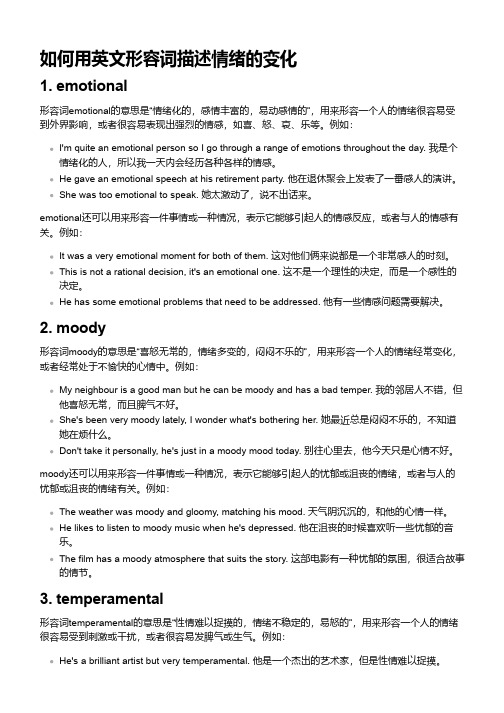
如何用英文形容词描述情绪的变化1. emotional形容词emotional的意思是“情绪化的,感情丰富的,易动感情的”,用来形容一个人的情绪很容易受到外界影响,或者很容易表现出强烈的情感,如喜、怒、哀、乐等。
例如:I'm quite an emotional person so I go through a range of emotions throughout the day. 我是个情绪化的人,所以我一天内会经历各种各样的情感。
He gave an emotional speech at his retirement party. 他在退休聚会上发表了一番感人的演讲。
She was too emotional to speak. 她太激动了,说不出话来。
emotional还可以用来形容一件事情或一种情况,表示它能够引起人的情感反应,或者与人的情感有关。
例如:It was a very emotional moment for both of them. 这对他们俩来说都是一个非常感人的时刻。
This is not a rational decision, it's an emotional one. 这不是一个理性的决定,而是一个感性的决定。
He has some emotional problems that need to be addressed. 他有一些情感问题需要解决。
2. moody形容词moody的意思是“喜怒无常的,情绪多变的,闷闷不乐的”,用来形容一个人的情绪经常变化,或者经常处于不愉快的心情中。
例如:My neighbour is a good man but he can be moody and has a bad temper. 我的邻居人不错,但他喜怒无常,而且脾气不好。
She's been very moody lately, I wonder what's bothering her. 她最近总是闷闷不乐的,不知道她在烦什么。
穆迪手册
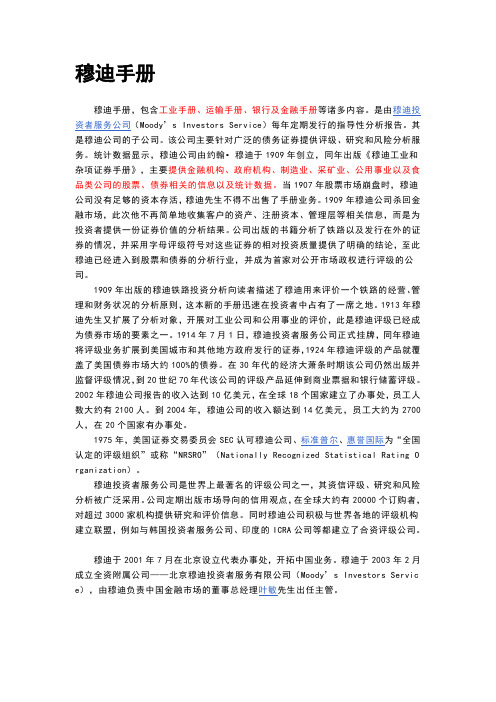
穆迪手册穆迪手册,包含工业手册、运输手册、银行及金融手册等诸多内容。
是由穆迪投资者服务公司(Moody’s Investors Service)每年定期发行的指导性分析报告。
其是穆迪公司的子公司。
该公司主要针对广泛的债务证券提供评级、研究和风险分析服务。
统计数据显示,穆迪公司由约翰•穆迪于1909年创立,同年出版《穆迪工业和杂项证券手册》,主要提供金融机构、政府机构、制造业、采矿业、公用事业以及食品类公司的股票、债券相关的信息以及统计数据。
当1907年股票市场崩盘时,穆迪公司没有足够的资本存活,穆迪先生不得不出售了手册业务。
1909年穆迪公司杀回金融市场,此次他不再简单地收集客户的资产、注册资本、管理层等相关信息,而是为投资者提供一份证券价值的分析结果。
公司出版的书籍分析了铁路以及发行在外的证券的情况,并采用字母评级符号对这些证券的相对投资质量提供了明确的结论,至此穆迪已经进入到股票和债券的分析行业,并成为首家对公开市场政权进行评级的公司。
1909年出版的穆迪铁路投资分析向读者描述了穆迪用来评价一个铁路的经营、管理和财务状况的分析原则,这本新的手册迅速在投资者中占有了一席之地。
1913年穆迪先生又扩展了分析对象,开展对工业公司和公用事业的评价,此是穆迪评级已经成为债券市场的要素之一。
1914年7月1日,穆迪投资者服务公司正式挂牌,同年穆迪将评级业务扩展到美国城市和其他地方政府发行的证券,1924年穆迪评级的产品就覆盖了美国债券市场大约100%的债券。
在30年代的经济大萧条时期该公司仍然出版并监督评级情况,到20世纪70年代该公司的评级产品延伸到商业票据和银行储蓄评级。
2002年穆迪公司报告的收入达到10亿美元,在全球18个国家建立了办事处,员工人数大约有2100人。
到2004年,穆迪公司的收入额达到14亿美元,员工大约为2700人,在20个国家有办事处。
1975年,美国证券交易委员会SEC认可穆迪公司、标准普尔、惠誉国际为“全国认定的评级组织”或称“NRSRO”(Nationally Recognized Statistical Rating O rganization)。
保粹评级字母代码 -回复
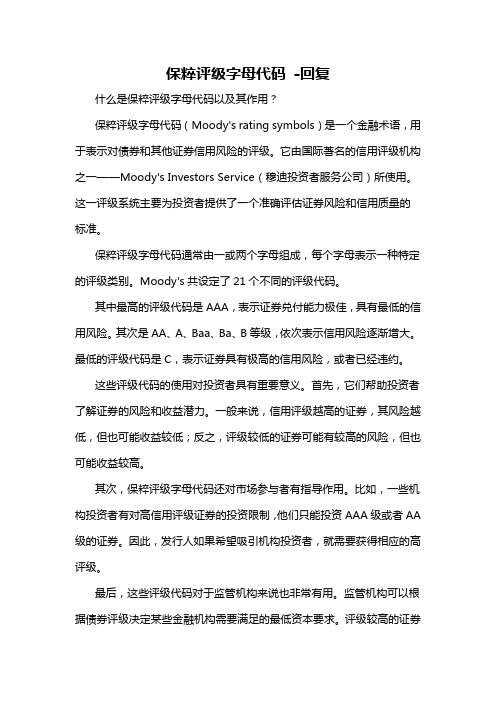
保粹评级字母代码-回复什么是保粹评级字母代码以及其作用?保粹评级字母代码(Moody's rating symbols)是一个金融术语,用于表示对债券和其他证券信用风险的评级。
它由国际著名的信用评级机构之一——Moody's Investors Service(穆迪投资者服务公司)所使用。
这一评级系统主要为投资者提供了一个准确评估证券风险和信用质量的标准。
保粹评级字母代码通常由一或两个字母组成,每个字母表示一种特定的评级类别。
Moody's共设定了21个不同的评级代码。
其中最高的评级代码是AAA,表示证券兑付能力极佳,具有最低的信用风险。
其次是AA、A、Baa、Ba、B等级,依次表示信用风险逐渐增大。
最低的评级代码是C,表示证券具有极高的信用风险,或者已经违约。
这些评级代码的使用对投资者具有重要意义。
首先,它们帮助投资者了解证券的风险和收益潜力。
一般来说,信用评级越高的证券,其风险越低,但也可能收益较低;反之,评级较低的证券可能有较高的风险,但也可能收益较高。
其次,保粹评级字母代码还对市场参与者有指导作用。
比如,一些机构投资者有对高信用评级证券的投资限制,他们只能投资AAA级或者AA 级的证券。
因此,发行人如果希望吸引机构投资者,就需要获得相应的高评级。
最后,这些评级代码对于监管机构来说也非常有用。
监管机构可以根据债券评级决定某些金融机构需要满足的最低资本要求。
评级较高的证券被认为风险较低,因此相关机构需要拨备的资本较少。
不过,需要指出的是,保粹评级字母代码也有一些限制和缺点。
首先,它只是一种评级工具,不能预测未来的市场表现。
其次,评级机构自身的独立性和公正性一直备受争议。
有时,评级机构的评级结果会受到发行人的影响,从而导致评级错误或滞后。
总结起来,保粹评级字母代码是一种重要的金融术语,用于表示债券和证券的信用风险等级。
它对投资者、市场参与者和监管机构都有着重要的指导作用。
外貌性格英语词汇
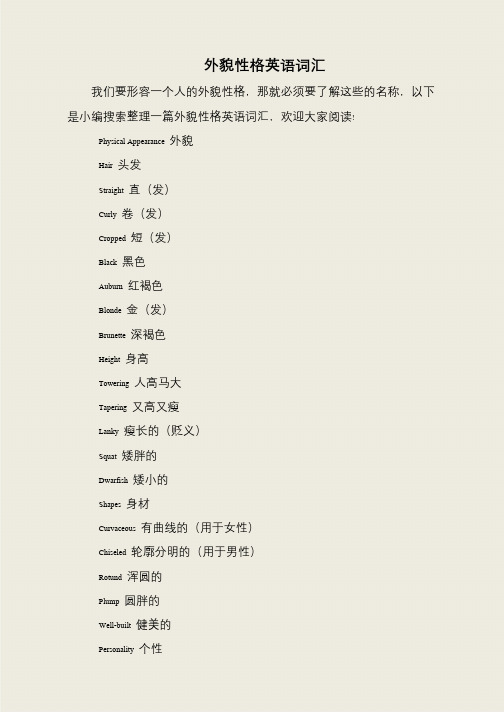
Towering人高马大
Tapering又高又瘦
Lanky瘦长的(贬义)
Squat矮胖的
Dwarfish矮小的
Shapes身材
Curvaceous有曲线的(用于女性)
Chiseled轮廓分明的(用于男性)
Rotund浑圆的
Plump圆胖的
Well-built健美的
Personality个性
Sophisticated世故的
Grumpy性格暴躁的
Humorous幽默的
Excitable易激动的
Industrious勤奋的
Style时尚风格
Flamboyant华丽浮夸
Chic时髦雅致
Eclectic兼收并蓄
Modest简约端庄
Casuaห้องสมุดไป่ตู้休闲
tips:感谢大家的阅读,本文由我司收集整编。仅供参阅!
Adorable可爱的
Clever聪明的
Intelligent智慧的,理解力强的
Generous慷慨的
Mysterious神秘的,难懂的
Creative富有创造力的
Flexible灵活的,能变通的
Sensitive敏感的
Moody情绪化的
Snobbish势利的;自命不凡的
Sensible理智的
Emotional感性的
外貌性格英语词汇
我们要形容一个人的外貌性格,那就必须要了解这些的名称,以下
是小编搜索整理一篇外貌性格英语词汇,欢迎大家阅读!
Physical Appearance外貌
Hair头发
Straight直(发)
Curly卷(发)
Cropped短(发)
Black黑色
- 1、下载文档前请自行甄别文档内容的完整性,平台不提供额外的编辑、内容补充、找答案等附加服务。
- 2、"仅部分预览"的文档,不可在线预览部分如存在完整性等问题,可反馈申请退款(可完整预览的文档不适用该条件!)。
- 3、如文档侵犯您的权益,请联系客服反馈,我们会尽快为您处理(人工客服工作时间:9:00-18:30)。
Position Title: Consultant/ Lead consultant
Reports To: Chief Representative for China, MACS
LOB / Location: Moody’s Analytics Consulting Services (MACS) / Beijing
The Role:
The main objective for this role is to deliver customized analytic solutions based on a vast array of products, services, and intellectual property provided by Moody’s Analytics. He/She must be flexible and energetic to excel in this ever-changing business environment. It is essential for this role to demonstrate an understanding of the issues and challenges facing by our clients as well as to maintain knowledge base of the strengths and capabilities of Moody’s Analytics.
As part of Moody’s Analytics Consulting Services team, this role is responsible for delivering Moody’s customized solutions. The primary constituency is banks, insurance companies, investment managers, corporate treasurers and hedge funds within this region.
Responsibilities:
∙Working as part of a team to effectively deliver solutions for clients. The solutions could be models, various types of reports and analyses, and other consulting services.
∙Credit risk model development, validation and calibration, and other quantitative and qualitative analysis for credit risk assessment.
∙Provide framework for enhancing cli ent’s credit related processes.
∙Developing and presenting project results and materials to clients.
∙Assisting in management of projects to deliver projects and deliverables in an effective and timely manner.
∙Working closely with client engagement team and sales team, including developing and presenting pre-sales materials and client proposals.
Requirements:
∙ A master degree in economics, finance, or a related field.
∙Strong knowledge of the capital and credit markets and financial products.
∙Working knowledge of MS Access, SAS, or similar data management and statistical programming software.
∙Experience in commercial credit risk management or related discipline.
∙Experience with or a general understanding of modelling techniques.
∙Experience in training, presentations and/or workshop facilitation.
∙Excellent client service orientation, previous consulting experience is a plus.
∙Familiarity with commercial lending practices and financial institution practices relating to credit risk management. Knowledge of retail or specialized lending ratings process also considered.
∙Strong grasp of Basel II guidelines.
∙Analytical experience in commercial credit risk modelling, credit risk management or consulting.
∙Fluent in Mandarin and English and other foreign language skills a plus.
∙Strong communication skills both in writing and speaking.
∙Proficiency in MS Excel, Word, Access and PowerPoint.
∙High-level local financial institution contacts and/or banking experience a major plus.
∙Strong project management skills, relationship management skills and analytical abilities essential. ∙Familiarity with IFR and accounting principles suggested.
∙May require over 25% travel, with the potential for international travel.。
